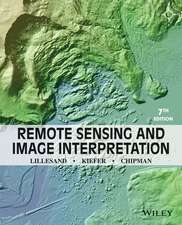Geometric Constraints for Object Detection and Delineation: The Springer International Series in Engineering and Computer Science, cartea 530
Autor Jefferey Shufelten Limba Engleză Paperback – 11 oct 2012
PIVOT, the fully automated system implementing these techniques, is quantitatively evaluated on 83 images covering 18 test scenes, and compared to three existing systems for building extraction. The results highlight the performance improvements possible with rigorous photogrammetric camera modeling, primitive-based object representations, and geometric constraints derived from their combination. PIVOT's performance illustrates the implications of a clearly articulated set of philosophical principles, taking a significant step towards automatic detection and delineation of 3D objects in real-world environments.
Geometric Constraints for Object Detection and Delineation is suitable as a textbook or as a secondary text for a graduate-level course, and as a reference for researchers and practitioners in industry.
| Toate formatele și edițiile | Preț | Express |
|---|---|---|
| Paperback (1) | 938.34 lei 43-57 zile | |
| Springer Us – 11 oct 2012 | 938.34 lei 43-57 zile | |
| Hardback (1) | 950.03 lei 43-57 zile | |
| Springer Us – 30 noi 1999 | 950.03 lei 43-57 zile |
Din seria The Springer International Series in Engineering and Computer Science
- 24%
 Preț: 1041.97 lei
Preț: 1041.97 lei - 20%
 Preț: 643.50 lei
Preț: 643.50 lei - 18%
 Preț: 1225.62 lei
Preț: 1225.62 lei - 18%
 Preț: 965.02 lei
Preț: 965.02 lei - 20%
 Preț: 646.12 lei
Preț: 646.12 lei - 18%
 Preț: 948.79 lei
Preț: 948.79 lei - 20%
 Preț: 646.62 lei
Preț: 646.62 lei - 15%
 Preț: 637.46 lei
Preț: 637.46 lei - 20%
 Preț: 643.83 lei
Preț: 643.83 lei - 18%
 Preț: 949.23 lei
Preț: 949.23 lei - 20%
 Preț: 644.48 lei
Preț: 644.48 lei - 20%
 Preț: 994.92 lei
Preț: 994.92 lei - 20%
 Preț: 645.97 lei
Preț: 645.97 lei - 18%
 Preț: 946.87 lei
Preț: 946.87 lei - 20%
 Preț: 995.57 lei
Preț: 995.57 lei - 18%
 Preț: 956.99 lei
Preț: 956.99 lei - 20%
 Preț: 644.98 lei
Preț: 644.98 lei - 15%
 Preț: 649.54 lei
Preț: 649.54 lei - 18%
 Preț: 950.21 lei
Preț: 950.21 lei - 18%
 Preț: 1221.38 lei
Preț: 1221.38 lei - 18%
 Preț: 957.62 lei
Preț: 957.62 lei - 15%
 Preț: 643.99 lei
Preț: 643.99 lei - 18%
 Preț: 948.47 lei
Preț: 948.47 lei - 18%
 Preț: 947.35 lei
Preț: 947.35 lei - 20%
 Preț: 1284.65 lei
Preț: 1284.65 lei - 20%
 Preț: 1633.95 lei
Preț: 1633.95 lei - 20%
 Preț: 1285.78 lei
Preț: 1285.78 lei
Preț: 938.34 lei
Preț vechi: 1144.32 lei
-18% Nou
Puncte Express: 1408
Preț estimativ în valută:
179.57€ • 186.34$ • 150.09£
179.57€ • 186.34$ • 150.09£
Carte tipărită la comandă
Livrare economică 17-31 martie
Preluare comenzi: 021 569.72.76
Specificații
ISBN-13: 9781461374053
ISBN-10: 1461374057
Pagini: 280
Ilustrații: X, 265 p.
Dimensiuni: 155 x 235 x 15 mm
Greutate: 0.4 kg
Ediția:Softcover reprint of the original 1st ed. 2000
Editura: Springer Us
Colecția Springer
Seria The Springer International Series in Engineering and Computer Science
Locul publicării:New York, NY, United States
ISBN-10: 1461374057
Pagini: 280
Ilustrații: X, 265 p.
Dimensiuni: 155 x 235 x 15 mm
Greutate: 0.4 kg
Ediția:Softcover reprint of the original 1st ed. 2000
Editura: Springer Us
Colecția Springer
Seria The Springer International Series in Engineering and Computer Science
Locul publicării:New York, NY, United States
Public țintă
ResearchCuprins
1. Introduction.- 1.1 A survey of previous research.- 1.2 An approach for generic object detection and delineation.- 1.3 The role of geometry and structural cues.- 1.4 Main contributions of this book.- 2. Object Detection and Delineation.- 2.1 Modeling image geometry.- 2.2 Primitives: generic object models.- 2.3 Bounding hypothesis space.- 2.4 Modeling 3D effects.- 2.5 Evaluating performance.- 2.6 System structure.- 3. Primitives and Vanishing Points.- 3.1 Selecting primitives.- 3.2 Rectangular and triangular volumes.- 3.3 Previous methods for vanishing point detection.- 3.4 Primitive-based vanishing point detection.- 3.5 Edge error modeling.- 3.6 Performance evaluation and analysis.- 3.7 A summary of vanishing point analysis.- 4. Geometric Constraints for Hypothesis Generation.- 4.1 Corner detection.- 4.2 Corner constraints.- 4.3 2—corners.- 4.4 Performance evaluation of corner generation.- 4.5 Generating primitives from intermediate features.- 4.6 A summary of hypothesis generation.- 5. Combining and Verifying Primitives.- 5.1 Combining primitives in image space.- 5.2 Exploiting hypothesis lineage.- 5.3 From image space primitives to object space models.- 5.4 Primitive extension: extrusion methods.- 5.5 Hypothesis verification.- 5.6 General aspects of primitive manipulation and verification.- 6. Performance Evaluation and Analysis.- 6.1 Selecting evaluation metrics.- 6.2 Reference scene model compilation.- 6.3 Comparative performance evaluation methodology.- 6.4 Baseline performance results and comparative analysis.- 6.5 Image/scene complexity and its impact on performance.- 6.6 Detection and delineation performance case studies.- 6.7 Performance evaluation: conclusions.- 7. Conclusions.- 7.1 Research summary.- 7.2 Future research and applications.- Appendices.- A-Mathematical Tools.- A.1 Coordinate systems and transformations.- A.2 The Gaussian sphere.- A.3 Vanishing points.- A.4 Backprojection.- A.5 Finite image extent bias.- A.6 2D determinant tests.- B- Experimental Results.- References.- About the Author.










